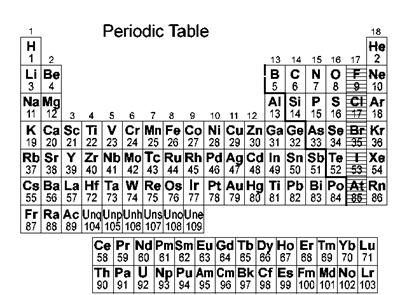
Concept explainers
(a)
Interpretation:
The two different versions of periodic table need to be represented by explaining similarity between them.
Concept introduction: There are two version of the periodic table −one of them proposed by Russian Chemist Dmitri Mendeleev’s known as the old Periodic table. Later on due to some demerits new form of Periodic table Modern form of the periodic table. A total of 118 elements is arranged in the form of a table. The periodic table has horizontal and vertical rows-Groups and Periods.
Answer to Problem 7E
Elements are arranged on the basis of
Explanation of Solution
In both forms of periodic table, elements are arranged in groups and periods.
Periodic table in which elements are arranged in increasing order to atomic mass is as follows:

The periodic table where elements are arranged in increasing order of atomic number is as follows:

(b)
Interpretation:
The two different versions of periodic table need to be represented by explaining difference between them.
Concept introduction: There are two version of the periodic table −one of them proposed by Russian Chemist Dmitri Mendeleev’s known as the old Periodic table. Later on due to some demerits new form of Periodic table Modern form of the periodic table. A total of 118 elements is arranged in the form of a table. The periodic table has horizontal and vertical rows-Groups and Periods.
Explanation of Solution
Elements are arranged on the basis of atomic mass and on the basis of the atomic number in two different periodic tables.


The noble gases or neon gases are present in group zero in the periodic table where elements are arranged in increasing order of atomic masses and they are present in group 18 when elements are arranged in increasing order of atomic number.
Chapter U1 Solutions
Living by Chemistry
Additional Science Textbook Solutions
Chemistry
CHEMISTRY-TEXT
Chemistry: Matter and Change
General Chemistry: Atoms First
Chemistry: A Molecular Approach (4th Edition)
Introductory Chemistry (6th Edition)
 ChemistryChemistryISBN:9781305957404Author:Steven S. Zumdahl, Susan A. Zumdahl, Donald J. DeCostePublisher:Cengage Learning
ChemistryChemistryISBN:9781305957404Author:Steven S. Zumdahl, Susan A. Zumdahl, Donald J. DeCostePublisher:Cengage Learning ChemistryChemistryISBN:9781259911156Author:Raymond Chang Dr., Jason Overby ProfessorPublisher:McGraw-Hill Education
ChemistryChemistryISBN:9781259911156Author:Raymond Chang Dr., Jason Overby ProfessorPublisher:McGraw-Hill Education Principles of Instrumental AnalysisChemistryISBN:9781305577213Author:Douglas A. Skoog, F. James Holler, Stanley R. CrouchPublisher:Cengage Learning
Principles of Instrumental AnalysisChemistryISBN:9781305577213Author:Douglas A. Skoog, F. James Holler, Stanley R. CrouchPublisher:Cengage Learning Organic ChemistryChemistryISBN:9780078021558Author:Janice Gorzynski Smith Dr.Publisher:McGraw-Hill Education
Organic ChemistryChemistryISBN:9780078021558Author:Janice Gorzynski Smith Dr.Publisher:McGraw-Hill Education Chemistry: Principles and ReactionsChemistryISBN:9781305079373Author:William L. Masterton, Cecile N. HurleyPublisher:Cengage Learning
Chemistry: Principles and ReactionsChemistryISBN:9781305079373Author:William L. Masterton, Cecile N. HurleyPublisher:Cengage Learning Elementary Principles of Chemical Processes, Bind...ChemistryISBN:9781118431221Author:Richard M. Felder, Ronald W. Rousseau, Lisa G. BullardPublisher:WILEY
Elementary Principles of Chemical Processes, Bind...ChemistryISBN:9781118431221Author:Richard M. Felder, Ronald W. Rousseau, Lisa G. BullardPublisher:WILEY





